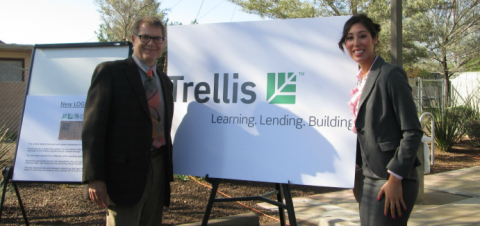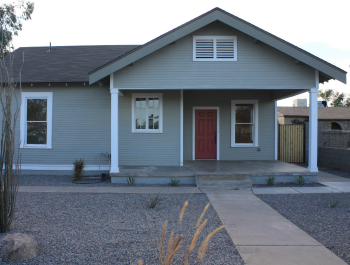Image

Carole Kauffman, VP, Director of Development & Communications, Trellis
Challenge: Certain areas in the city are targeted for revitalization to arrest blight, fill vacant homes and stabilize impacted neighborhoods. One such area encompasses the Montana Bella subdivision on the northeast corner of 7th Avenue and South Mountain Avenue just south of Baseline. In this location Trellis, an affordable housing nonprofit, found a place where their mission could take root. Our mission at Trellis is to make stable homes and communities possible by educating, building and lending. One of our strategic goals is to create affordable housing opportunities to assist the underserved to achieve sustainable housing. Under this goal our objectives include: acquire, rehab or build new affordable housing in target neighborhoods and enhance community stabilization and revitalization.
Across the nation, the housing crisis that began in 2007-2008 took its toll on communities, homeowners and prospective buyers. It was especially felt in Phoenix, consistently one of the hardest hit areas in the country for foreclosures. But with challenges, come opportunities for those who are willing to take a risk.
Thanks to a loan from one of our financial partners and the “go-ahead” from our Board, Trellis purchased a vacant and abandoned partially-built subdivision at a Trustee sale in 2009 with 10 occupied homes, 16 partially-built homes and 18 vacant lots. We completed the unfinished homes, sold 14, rented out two and patiently waited for the market to recover before building on the remaining lots.
The risk Trellis took on was not insubstantial, given the thousands of vacant lots spread across the Phoenix market. According to an estimate from Nathan and Associates, a residential land brokerage firm based in Scottsdale, at the end of 2009 there were as many as 40,000 unfinished lots in the Phoenix market.
This enforced delay gave us time to assess the future buying market. We recognized that the Baby Boomer generation wanted to “age-in-place” and would look for homes that would allow them to do so. According to a survey from AARP, 71 percent of adults nationally between 50-64 want to age in place. We also learned that the millennial generation would soon be interested in homeownership and being “conservation-focused”, they’d be interested in sustainable development. Unfortunately, we know that the homeownership dreams of millennials might have to be delayed because of student debt. Various surveys, including one from NeighborWorks America note that student loan debt ranks among the top three obstacles to homeownership by millennials. However, creative multi-generational development might satisfy both cohorts’ needs.
Taking our cue from indications that the housing market was recovering in 2012-2013, we set out to plan our new houses to finish out this subdivision.
 We developed designs and used computer-based tools to simulate and assess the energy use of a home in order to quantify the savings attributable to the proposed design. By June 2015 we had sufficient capital investment to break ground. By the end of that year we had completed nine homes with three floor plans, all designed to promote maximum maneuverability and control; all with multigenerational options including plans with two master suites and private suites with separate entrances; all energy-efficient with a “silver” certification for green standards. According to the United States Green Building Council, more than half of consumers rank green and energy efficiency as a top requirement for their next homes.
We developed designs and used computer-based tools to simulate and assess the energy use of a home in order to quantify the savings attributable to the proposed design. By June 2015 we had sufficient capital investment to break ground. By the end of that year we had completed nine homes with three floor plans, all designed to promote maximum maneuverability and control; all with multigenerational options including plans with two master suites and private suites with separate entrances; all energy-efficient with a “silver” certification for green standards. According to the United States Green Building Council, more than half of consumers rank green and energy efficiency as a top requirement for their next homes.In addition to this standard, all of the homes we built were fully accessible for persons with disabilities which include zero-clearance steps, wider door and hallways and conveniently located electrical outlets. Residents will feel confident that their home is ready for all of life’s changes, unexpected or not.
The result of this planning was clear. Within the first month after opening we had hundreds of showings and closed on four contracts. Positive comments from potential buyers convinced us that we “did it right.” From quality workmanship to upgraded finishes, from energy-saving features to flexible floor plans that can accommodate varied generations, from universal design features that can be modified to accommodate any disability, these affordable homes, currently offered at $175,000 - $195,000, meet the demand for homes that working individuals and families can afford in today’s Phoenix market and enjoy for a lifetime.
As we reflect on our initial risk to purchase this abandoned subdivision, several lessons become clear, including:
- Calculated risks, only taken after assessing the environment, proved critical in being able to move forward when the time was right
- Thinking about new construction, coming out of the housing crisis, taught us a lesson in patience. We waited until the market had improved before we tackled new builds
- The luxury of time that we had to research and model before breaking ground taught us that the upfront investment we put into due diligence paid off in being able to design and construct homes with features that will have a better return-on-investment for our clients in the long term
- Despite claims from the homebuilding community to the contrary, we could include green features at the silver level cost-effectively to target entry-level buyers who will reap the cost-savings.
What we’ve learned will inform us as we get ready to start on completing the final eight homes that will be even more energy-efficient.

